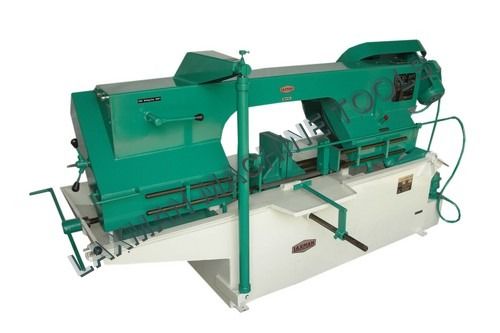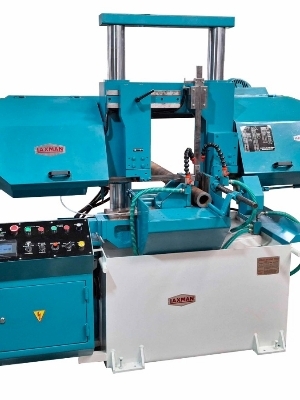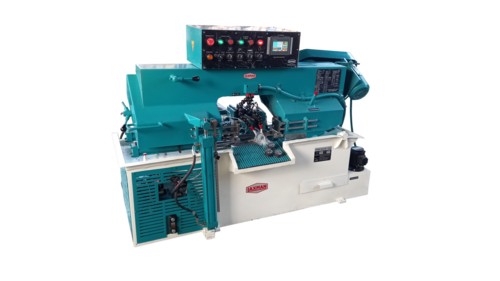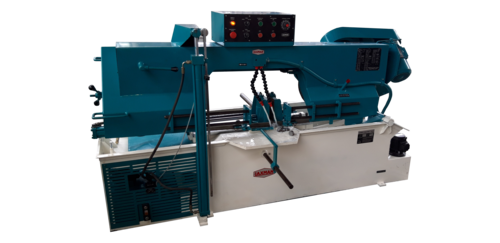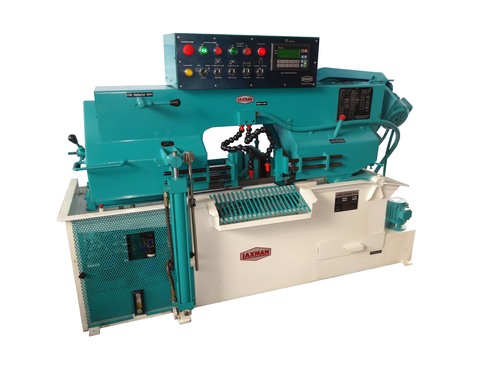Metal Cutting Bandsaw Machine
Product Details:
Metal Cutting Bandsaw Machine Price And Quantity
- 210000 INR
- 1 Unit
Metal Cutting Bandsaw Machine Trade Information
- Asia Australia Central America North America South America Eastern Europe Western Europe Middle East Africa
- All India
Product Description
A sort of power tool used for cutting metal, notably in industrial and fabrication environments, is a bandsaw machine. It cuts through different kinds of metal by employing a continuous loop of a toothed blade known as a bandsaw blade.
Typical characteristics of a bandsaw machine used for metal cutting include the following:
1. Bandsaw Blade: A bandsaw blade has teeth along one edge and is long, narrow, and flexible. It is made specifically to cut metal and is typically made of high-speed steel (HSS) or carbide. The blade, which forms a continuous loop, is supported by two wheels: an upper wheel and a lower wheel.
2. Cutting Capacity: Bandsaws used for cutting metal come in a variety of sizes and have variable cutting capabilities. The maximum size and shape of the workpiece that the machine can accept and properly cut is referred to as the cutting capacity.
3. Blade Tensioning System: The bandsaw blade is subjected to tension by the system to keep it taut while cutting. The right blade tension is essential for precise and effective cutting.
4. Bandsaw machines offer the option of altering the cutting speed to fit various metal types and cutting requirements. Harder metals are often cut at lower rates while softer materials are typically cut at higher speeds.
5. Adjustable cutting angle: Some bandsaw machines allow for slanted cuts by tilting the cutting table or the saw head. When cutting bevels or other angled profiles in the metal, this capability is helpful.
6. Coolant System: Metal cutting produces heat, hence bandsaw machines frequently use a coolant system. It aids in lubricating the blade, cooling the workpiece, and extending the life of the blade. Applying soluble oils or emulsions to the cutting zone are examples of common coolants.
7. Workholding Mechanism: Bandsaw machines frequently come with a workholding mechanism to ensure stability and accuracy during cutting. The workpiece can be held firmly in place while being fed into the blade using a vice, clamps or other tools.
8. Modern bandsaw machines may have a control panel that may be used to change settings like coolant flow and blade speed. Even programmable controls for automated cutting processes may be found in more sophisticated versions.
In the metalworking industry, bandsaw machines are frequently used to cut metal stock in a variety of forms and sizes, including solid bars, tubes, pipes, and profiles. They have the benefits of great cutting accuracy, less material waste, and the capacity to effectively cut through resistant materials.
FAQ
1. What is a bandsaw machine for cutting metal?
Ans - A machine tool called a metal-cutting bandsaw is made to cut metal using a blade made of a continuous band of metal that spins on two wheels.
2. How Does a Bandsaw Machine for Metal Cutting Operate?
Ans - A continuous band of metal that is both exceptionally strong and flexible is used as the cutting blade in metal cutting bandsaws. The band cuts as it moves through the material while running on two pulleys. The band has a motor that powers it, and the accuracy of the cuts is ensured by a guide mechanism.
3. How much metal can a metal cutting bandsaw machine cut at once?
Ans - A metal-cutting bandsaw's maximum cutting capacity is influenced by the machine's size and motor output. Up to 4" of steel, 2" of aluminium, and 5" of brass can be cut on a standard 14" machine
4. What kind of maintenance is necessary for a bandsaw machine that cuts metal?
Ans - Bandsaws for cutting metal need routine maintenance to operate safely and optimally. This include regularly lubricating the blades, checking the band's tension, and making sure the guides are set up correctly.
5. Are bandsaw machines for cutting metal risky to operate?
Ans - Yes, improper use of bandsaws for cutting metal can be dangerous. Wearing protective clothing is a must whenever using the machine. Additionally, safety barriers must be in place to shield the operator from the rotating blade.

Price:
- 50
- 100
- 200
- 250
- 500
- 1000+
Other Products in 'Horizontal Band Saw Machine' category
 |
LAXMAN MACHINE TOOLS
All Rights Reserved.(Terms of Use) Developed and Managed by Infocom Network Private Limited. |

 Send Inquiry
Send Inquiry